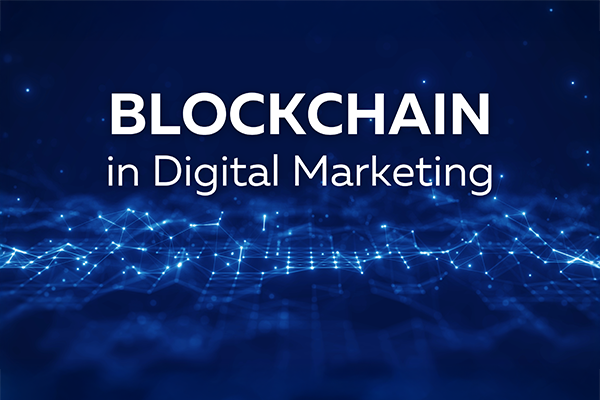
Blockchain in Digital Marketing, the technology behind cryptocurrencies, is making waves in digital marketing by enhancing transparency, security, and efficiency. It enables marketers to create more trustworthy and effective campaigns while fostering better relationships with consumers. Here’s an in-depth exploration of blockchain in digital marketing.
Table of Contents
ToggleWhat is Blockchain?
At its core, blockchain is a decentralized digital ledger that records transactions across multiple computers. This distributed nature ensures that no single entity controls the entire chain, thereby promoting transparency and security. Each “block” in the chain contains a batch of transactions, and once a block is completed, it is added to the chain in a linear, chronological order. The cryptographic nature of the blockchain ensures that once data is recorded, it cannot be easily altered, making it highly secure and tamper-resistant.
Blockchain’s decentralized design has several benefits:
- Security: The distributed ledger is highly resistant to hacking and fraud.
- Transparency: Every transaction is recorded and visible to all participants, which fosters trust.
- Efficiency: By eliminating the need for intermediaries, blockchain can streamline processes and reduce costs.
- Immutability: Once information is added to the blockchain, it is nearly impossible to modify, ensuring data integrity.
The Mechanics of Blockchain
Blockchain operates on consensus mechanisms—protocols that ensure all participants agree on the validity of transactions. The most common consensus mechanisms include:
- Proof of Work (PoW): Used by Bitcoin, PoW requires participants (miners) to solve complex mathematical puzzles to validate transactions and add new blocks. This process, although secure, is energy-intensive.
- Proof of Stake (PoS): In PoS systems, validators are chosen based on the number of tokens they hold and are willing to “stake” as collateral. This method is more energy-efficient than PoW.
- Other Mechanisms: There are several emerging mechanisms such as Delegated Proof of Stake (DPoS) and Practical Byzantine Fault Tolerance (PBFT), each with its unique benefits and trade-offs.
Applications of Blockchain in Digital Marketing
Enhanced Transparency
How It Works: Blockchain records all transactions and ad placements in an immutable ledger.
Benefit: Advertisers can verify where their ads are displayed, ensuring genuine placements and eliminating fraud.
Example: Marketers can confirm that their ad impressions are reaching actual users, not bots.
Fraud Prevention in Advertising
How It Works: Blockchain in Digital Marketing tracks ad spending and ensures payment is made only for valid clicks or impressions.
Benefit: Reduces ad fraud by eliminating fake clicks and impressions generated by bots.
Example: Platforms like Ads.txt and Verasity use blockchain to verify ad interactions.
Improved Data Privacy
How It Works: Blockchain gives users control over their data by decentralizing its storage.
Benefit: Businesses comply with privacy laws like GDPR and gain consumer trust by offering secure data handling.
Example: Consumers can choose what personal information to share with brands in exchange for personalized offers.
Tokenized Rewards for Engagement
How It Works: Brands use blockchain-based tokens to reward customers for engagement.
Benefit: Increases loyalty and encourages participation in campaigns.
Example: A brand offers cryptocurrency tokens to users who share content or write reviews.
Smart Contracts for Partnerships
How It Works: Smart contracts automate agreements between advertisers and publishers.
Benefit: Ensures payments are made only when predefined conditions are met.
Example: A publisher receives payment automatically once an ad achieves a set number of clicks.
Supply Chain Transparency
How It Works: Roll of Blockchain in Digital Marketing traces the journey of products from creation to delivery.
Benefit: Adds authenticity to marketing claims, such as “ethically sourced” or “sustainable.”
Example: A coffee company uses blockchain to prove its beans are sourced from fair-trade farms.
Eliminating Intermediaries
How It Works: Blockchain connects advertisers directly with consumers, bypassing middlemen like ad networks.
Benefit: Reduces costs and ensures higher ROI for campaigns.
Example: Platforms like Brave Browser allow direct interaction between brands and users.
Verified Influencer Marketing
How It Works: The essential roll of Blockchain in Digital Marketing tracks an influencer’s audience authenticity and engagement metrics.
Benefit: Ensures brands work with genuine influencers and reach real audiences.
Example: A blockchain system confirms that an influencer’s followers are real and not bots.
Benefits of Blockchain in Digital Marketing
Increased Trust: Blockchain ensures transparency in ad placements and spending.
Better ROI: Accurate tracking and fraud prevention maximize marketing budgets.
Enhanced Customer Relationships: Secure data handling fosters trust and loyalty.
Compliance with Regulations: Blockchain supports adherence to privacy laws like
GDPR and CCPA.
Challenges of Using Blockchain in Digital Marketing
High Implementation Costs: Adopting blockchain technology requires significant investment.
Scalability Issues: Processing large volumes of data in real-time can be slow.
Lack of Awareness: Many marketers are unfamiliar with blockchain applications.
Complexity: Integrating blockchain into existing systems requires technical expertise.
Blockchain Timeline: Key Milestones and Resources
Understanding the evolution of blockchain helps illustrate its rapid development and expanding influence. Below is a detailed timeline highlighting major milestones, complete with links for further reading:
-
2008 – Bitcoin Whitepaper Released
The blockchain revolution began when Satoshi Nakamoto published the Bitcoin whitepaper in 2008, introducing the concept of a decentralized digital currency. This document laid the groundwork for the modern blockchain era. -
2009 – Bitcoin Genesis Block Mined
In 2009, the very first block of the Bitcoin blockchain—known as the genesis block—was mined. This event marked the official launch of blockchain technology. -
2011 – Rise of Altcoins
Following Bitcoin’s success, alternative cryptocurrencies (altcoins) such as Litecoin emerged in 2011, expanding the blockchain ecosystem. For more details, visit the Litecoin Official Site. -
2013 – Ethereum Whitepaper Published
In 2013, Vitalik Buterin introduced Ethereum through its whitepaper, which proposed a blockchain platform capable of executing smart contracts. This innovation is detailed in the Ethereum Whitepaper. -
2015 – Ethereum Network Launches
Ethereum officially went live in 2015, providing a platform for decentralized applications (dApps) and smart contracts. This marked a significant leap in blockchain’s capabilities. Discover more about Ethereum here. -
2017 – ICO Boom
The surge of Initial Coin Offerings (ICOs) in 2017 allowed blockchain startups to raise funds by issuing new digital tokens. Although this period sparked immense innovation, it also underscored the need for regulatory oversight. Read more about ICOs on Wikipedia. -
2020 – DeFi (Decentralized Finance) Emergence
In 2020, decentralized finance platforms began to flourish, offering blockchain-based alternatives to traditional financial services. This era marked a new chapter in democratizing access to financial products. Learn the basics of DeFi from Coindesk’s guide. -
2021 – NFT Explosion
Non-Fungible Tokens (NFTs) exploded into popularity in 2021, revolutionizing digital art and collectibles. NFTs offered a new way to prove ownership and authenticity in the digital realm. Explore the world of NFTs on Wikipedia. -
2022 – Mainstream Adoption and Innovation
Blockchain technology expanded into new industries such as supply chain management, digital identity, and digital marketing in 2022. The technology continued to mature, integrating with existing systems and fostering innovation. For more insights, check out IBM’s blockchain overview. -
2023 – Regulatory Clarity and Integration
The year 2023 saw the development of clearer regulatory frameworks, boosting institutional confidence in blockchain. Innovations in Web3, DeFi, and NFTs matured, facilitating broader adoption. Read more about regulatory developments at Coindesk Policy. -
2024 – Expansion of CBDCs and Cross-Chain Innovations
By 2024, many governments had begun piloting Central Bank Digital Currencies (CBDCs), and technological advancements made cross-chain interoperability more seamless. These developments paved the way for a more connected and integrated blockchain ecosystem. Explore recent CBDC developments on the Bank for International Settlements website and learn about cross-chain innovations. -
2025 – Mainstream Integration and Sustainable Blockchain Practices
Looking ahead to 2025, blockchain is anticipated to become even more integrated across various sectors. Future developments are expected to focus on scalability, energy efficiency, and sustainable practices. Continued research and real-world applications promise to deliver a secure, transparent, and efficient digital infrastructure. As the technology evolves, keep an eye on emerging trends and breakthroughs that will further shape our digital future.
Future of Blockchain in Digital Marketing
Looking ahead, blockchain is poised to become an integral part of our digital infrastructure. Here are some trends and innovations to watch for in the coming years:
Integration with Emerging Technologies: Blockchain is expected to work hand-in-hand with other cutting-edge technologies like artificial intelligence (AI), the Internet of Things (IoT), and big data analytics. This integration will unlock new use cases and drive further innovation.
Sustainable Practices: With increasing awareness of environmental issues, the blockchain community is focusing on creating more sustainable practices. Future developments will likely prioritize energy efficiency and environmental impact.
Wider Adoption Across Industries: Beyond finance and digital marketing, blockchain’s applications will expand into sectors like real estate, education, and governance. As technology matures and regulatory frameworks solidify, more industries will harness blockchain’s potential.
Enhanced Security Protocols: Continued advancements in cryptography and consensus mechanisms will further enhance the security and reliability of blockchain networks, making them even more resistant to cyber threats.
User-Centric Innovations: As the technology becomes more accessible, expect to see a surge in blockchain-based applications designed with the end user in mind. These innovations will simplify interactions and increase adoption among the general public.
Conclusion
Blockchain is revolutionizing digital marketing by providing transparency, reducing fraud, and fostering trust. While challenges exist, its potential to reshape the industry is immense. As technology advances, adopting blockchain will become essential for marketers aiming to stay ahead in a competitive landscape.

